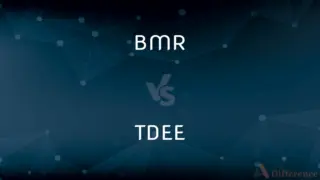Discount Rate vs. Interest Rate — What's the Difference?
By Tayyaba Rehman — Published on January 8, 2024
The discount rate is the interest rate charged by central banks on loans to commercial banks, influencing monetary policy. The interest rate is the cost of borrowing money, generally set by financial institutions for loans to individuals and businesses.

Difference Between Discount Rate and Interest Rate
Table of Contents
ADVERTISEMENT
Key Differences
The discount rate, often set by a central bank, is the rate charged to commercial banks for borrowing short-term funds directly from the central bank. It's a tool used to control the money supply and influence broader economic activity. The interest rate, on the other hand, is the percentage charged on the total amount of borrowed money and is determined by individual lending institutions based on various economic factors.
Discount rates directly affect the lending capacity of commercial banks and, consequently, the economy's liquidity. Lower discount rates encourage banks to borrow more, increasing money supply and stimulating economic activity. Interest rates directly affect the cost of loans for consumers and businesses, influencing spending, saving, and investment behavior.
Changes in the discount rate can signal a central bank's monetary policy stance, such as a focus on stimulating growth or controlling inflation. Interest rates fluctuate based on market conditions, including the central bank's monetary policy, inflation expectations, and the demand for and supply of credit.
The discount rate is typically lower than the interest rates on loans and credit products offered to consumers and businesses, as it's a tool to manage economic stability. Interest rates include a premium over the cost of funds to cover the risk of lending and to generate profit for the lender.
In practical terms, the discount rate is more of a macroeconomic tool, affecting overall economic conditions, while interest rates are more directly related to individual financial products like loans, mortgages, and savings accounts.
ADVERTISEMENT
Comparison Chart
Set By
Central banks.
Financial institutions and market conditions.
Purpose
Influence monetary policy and money supply.
Cost of borrowing for consumers and businesses.
Influence
Directly affects banking system liquidity.
Affects individual spending, saving, investment.
Typical Rates
Lower than market interest rates.
Varies based on risk, policy, and market conditions.
Impact
Macro-level economic tool.
Direct impact on personal and business finances.
Compare with Definitions
Discount Rate
It's used as a monetary policy tool to control money supply.
The Federal Reserve adjusted the discount rate to stimulate economic growth.
Interest Rate
It varies based on credit risk, market conditions, and policy.
Interest rates on mortgages fluctuated with market trends.
Discount Rate
It helps regulate overall economic stability.
The central bank's discount rate decision impacted the stock market.
Interest Rate
Interest rates are key for savings and investment products.
Savings accounts offered lower interest rates due to economic slowdown.
Discount Rate
The discount rate is the interest rate central banks charge on loans to commercial banks.
The central bank raised the discount rate to curb inflation.
Interest Rate
Reflects the cost of credit in the economy.
Central bank policies indirectly influenced prevailing interest rates.
Discount Rate
Influences the cost of borrowing for commercial banks.
A lower discount rate encouraged banks to increase lending.
Interest Rate
Affects consumer and business borrowing decisions.
Higher interest rates discouraged her from refinancing her home.
Discount Rate
Discount rates often guide commercial bank rate decisions.
Commercial banks adjusted their interest rates following a discount rate change.
Interest Rate
Interest rate is the cost charged on borrowed money.
The bank offered a competitive interest rate on personal loans.
Common Curiosities
Why do central banks change the discount rate?
To influence monetary policy and control economic conditions like inflation.
Can commercial banks borrow at the discount rate?
Yes, but typically as a last resort for short-term needs.
How does the interest rate affect consumer spending?
Higher interest rates can reduce spending by increasing the cost of borrowing.
Is the discount rate the same in all countries?
No, it varies based on each country's central bank policies.
Can a consumer loan have a lower interest rate than the discount rate?
Typically, consumer loan rates are higher than the discount rate.
Do interest rates affect all loans and credit products?
Yes, they impact mortgages, personal loans, credit cards, etc.
What happens when the discount rate is reduced?
Lower discount rates can stimulate economic growth by encouraging bank lending.
Are interest rates on savings accounts influenced by the discount rate?
Indirectly, as they're influenced by broader market conditions and central bank policies.
Does the discount rate affect stock markets?
Yes, changes in the rate can influence investor confidence and market trends.
How often do central banks change the discount rate?
It varies, based on economic conditions and policy objectives.
Does a change in the interest rate affect existing loans?
It depends on whether the loan has a fixed or variable interest rate.
How do consumers typically learn about interest rate changes?
Through financial news, lender notifications, and banking updates.
How does a high interest rate affect savings?
High interest rates can encourage savings by offering better returns.
Does a high discount rate mean high consumer interest rates?
Generally, yes, as it increases the cost of funds for banks.
Can a person negotiate the interest rate on a loan?
Sometimes, depending on the lender's policies and the borrower's creditworthiness.
Share Your Discovery

Previous Comparison
BMR vs. TDEE
Next Comparison
DHCP vs. BOOTPAuthor Spotlight
Written by
Tayyaba RehmanTayyaba Rehman is a distinguished writer, currently serving as a primary contributor to askdifference.com. As a researcher in semantics and etymology, Tayyaba's passion for the complexity of languages and their distinctions has found a perfect home on the platform. Tayyaba delves into the intricacies of language, distinguishing between commonly confused words and phrases, thereby providing clarity for readers worldwide.













































